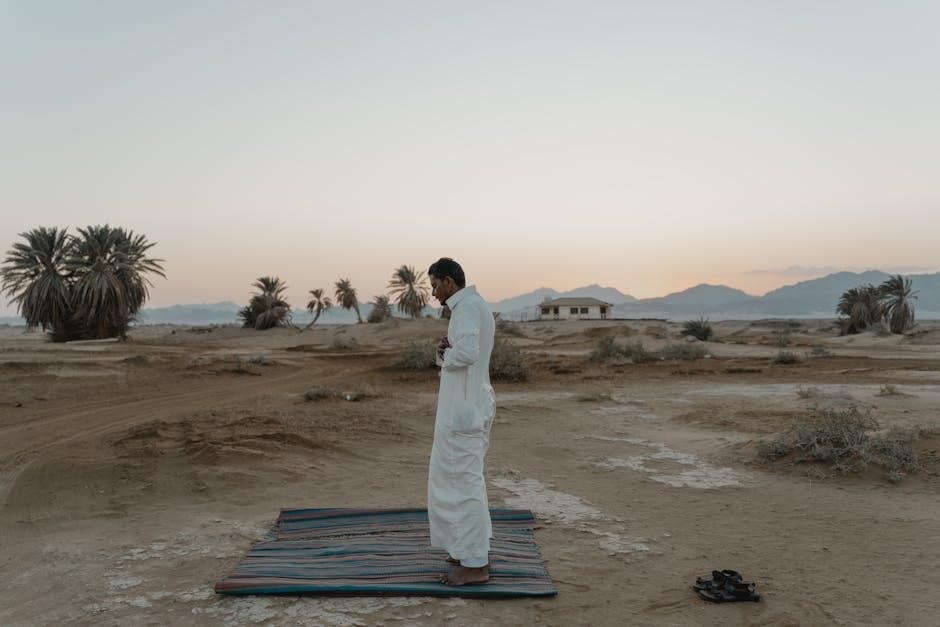Shacharit, the Jewish morning prayer, offers a structured approach to worship, combining blessings, psalms, and central prayers like Shema and Amidah, fostering spiritual connection and gratitude, now accessible via PDF resources and digital platforms for modern convenience and global accessibility.

Structure of Shacharit
Shacharit’s structured service includes Birkot haShachar, Pesukei dezimra, Shema with blessings, Amidah, and concluding prayers, organized in PDF formats for easy access and recitation, ensuring a meaningful and guided prayer experience.
2.1. Birkot haShachar (Morning Blessings)
Birkot haShachar, or Morning Blessings, are a series of prayers recited at the start of the Shacharit service, expressing gratitude for daily miracles and bodily functions. These blessings are found in the Siddur and are typically recited upon waking. They include praises for the soul’s return, the body’s functionality, and the gift of Torah. Many of these blessings are recited before putting on tallit and tefillin. The PDF versions of Shacharit prayers often include translations, making these blessings accessible to a broader audience. Birkot haShachar set a tone of appreciation and readiness for the day, serving as a foundational element of the morning prayer service. Their structure and significance are preserved in digital formats, ensuring their timeless relevance in Jewish worship.
2.2. Pesukei dezimra (Verses of Praise)
Pesukei dezimra, or “Verses of Praise,” is a collection of biblical psalms and hymns that follow Birkot haShachar in the Shacharit service. This segment is designed to express joy and gratitude through the recitation of sacred texts, including psalms like Psalm 100 and excerpts from Chronicles. Shir Shel Yom, a daily psalm corresponding to the day of the week, is also included in this section. The verses are meant to inspire a sense of awe and connection to the divine. In PDF versions of the Shacharit prayer, these passages are often presented with translations, making them accessible to a wider audience. Pesukei dezimra serves as a bridge between the morning blessings and the Shema, creating a harmonious flow of praise and reflection in the morning prayer service. Its inclusion in digital formats ensures its enduring relevance and accessibility for modern worshippers.
2.3. Shema and Its Blessings
The Shema is a cornerstone of Jewish prayer, declaring the unity of God and the commitment to follow His commandments. It consists of three biblical paragraphs: Deuteronomy 6:4-9, Deuteronomy 11:13-21, and Exodus 13:1-10. Recited twice daily, the Shema is central to Shacharit, expressing devotion and faith. In the Shacharit service, the Shema is preceded by two blessings: one invoking divine mercy and the other celebrating the greatness of God. A third blessing follows, emphasizing the covenant and divine providence. These blessings frame the Shema, enhancing its theological depth and emotional resonance.
In PDF versions of Shacharit, the Shema is often highlighted with clear typography and translations, aiding worshippers in understanding its profound message. This section reinforces Jewish identity and spiritual connection, making it a vital part of the morning prayer service.
2.4. Amidah (Standing Prayer)
The Amidah, also known as the Standing Prayer, is the core of the Shacharit service, reflecting deep personal and communal connection with God. Recited silently while standing, it consists of 19 blessings, originally 18, hence its name Shemoneh Esreh. The prayer is divided into three sections: praise, requests, and thanksgiving. On weekdays, it includes petitions for wisdom, forgiveness, health, and sustenance, while on Shabbat and holidays, a shorter version with seven blessings is used, focusing on the sanctity of the day. The Amidah is recited three times daily, with a fourth recitation on holidays. In PDF formats of Shacharit, the Amidah is often presented with clear instructions, translations, and commentary, facilitating meaningful recitation for both experienced worshippers and newcomers. This prayer embodies the essence of Jewish worship, fostering a dialogue between the individual and the divine.
2.5. Concluding Prayers
The concluding prayers of Shacharit serve as a final expression of gratitude and devotion, wrapping up the morning service. These prayers include Aleinu, which emphasizes the uniqueness of Jewish worship and the covenant with God, and Shir shel Yom, a daily psalm that varies according to the day of the week. Additional prayers like Eil Minimim and Tzidkatecha focus on themes of justice, righteousness, and divine mercy. These prayers are often recited with a sense of closure, preparing the individual to transition into their daily life with a renewed sense of purpose. In PDF versions of Shacharit, these concluding prayers are typically presented with clear translations and explanations, making them accessible for both experienced worshippers and those learning the service. This section reinforces the spiritual connection established during the earlier parts of the prayer.

Historical Development of Shacharit
The Shacharit service has evolved from early Jewish liturgical practices, influenced by rabbis like Rabbi Yohanan ben Zakkai and codified by the Men of the Great Assembly. Its structure reflects historical adaptations across Jewish communities, documented in PDF resources for modern study.
3.1. Evolution of the Morning Prayer Service
The Shacharit prayer service has its roots in the Second Temple era, evolving over centuries through rabbinic contributions and communal practices. Early sages like Rabbi Yohanan ben Zakkai and the Men of the Great Assembly played pivotal roles in shaping its structure. The Talmud and later codifiers, such as Maimonides and the Vilna Gaon, further refined the service, incorporating key prayers like the Shema and the Amidah. Historical texts and modern PDF versions of Shacharit reflect these developments, preserving ancient traditions while adapting to contemporary needs. This evolution ensures the morning prayer remains a vibrant and accessible practice for Jews worldwide, bridging past and present.
3.2. Adaptation into PDF Format
The adaptation of Shacharit into PDF format has revolutionized accessibility and convenience for modern worshippers. This digital transformation allows individuals to easily access the morning prayer service on devices, ensuring portability and ease of use. PDF versions often include the full text of prayers, transliterations, and translations, catering to diverse congregational needs. Many Siddurim now offer downloadable PDFs, enabling worshippers to follow the service seamlessly, even without physical copies. This format also preserves the traditional structure of Shacharit while incorporating modern features like bookmarks and search functions. The rise of digital platforms has made Shacharit PDFs widely available, fostering engagement and making the prayer service more approachable for both experienced practitioners and newcomers alike.

Significance of Shacharit in Jewish Practice
Shacharit is a cornerstone of Jewish worship, fostering gratitude, mindfulness, and connection to faith. Its structured prayers and blessings provide a meaningful framework for daily spiritual reflection and growth.
4.1. Role in Daily Jewish Worship
Shacharit serves as a cornerstone of daily Jewish worship, establishing a spiritual tone for the day. It fosters gratitude and divine awareness through its structured prayers and blessings. The service emphasizes connecting with the Almighty, reflecting on divine providence, and aligning oneself with Jewish tradition. By reciting Shacharit, individuals integrate faith into their daily routines, cultivating mindfulness and ethical behavior. The prayer also strengthens communal bonds, as Jews worldwide unite in reciting the same liturgy. Its morning timing symbolizes renewal and fresh opportunities for spiritual growth. The structured format ensures consistency, while its rich content provides depth, making it an indispensable part of Jewish religious practice and identity.
4.2. Spiritual and Emotional Benefits
Shacharit offers profound spiritual and emotional benefits, fostering a deep connection to faith and personal well-being. By beginning the day with prayer, individuals cultivate gratitude, mindfulness, and a sense of purpose. The service provides emotional solace, helping to navigate life’s challenges with resilience and hope. Reciting blessings and prayers like the Shema strengthens faith and trust in divine providence. The Amidah, a core component, allows for personal reflection and emotional expression, fostering inner peace. Engaging in Shacharit also enhances self-discipline and spiritual growth, while its rhythmic and repetitive nature creates a sense of balance and calm. This daily practice not only uplifts the spirit but also equips individuals to face life’s trials with joy and fortitude, making it a vital source of emotional and spiritual nourishment.
4.3. Communal and Individual Practice
Shacharit is uniquely suited for both communal and individual practice, offering flexibility and accessibility. In synagogues, the service fosters a sense of community and shared spiritual experience, with the congregation united in prayer. The presence of a minyan (quorum of ten) enhances the collective energy, particularly for prayers like the Shema and Amidah. However, Shacharit can also be recited individually, allowing for personal reflection and pacing. Many use PDF versions of the siddur to pray at home or while traveling, ensuring continuity in their spiritual practice. This duality reflects the balance between communal bonding and personal connection to faith, making Shacharit a versatile and enduring part of Jewish worship. Whether in a synagogue or private setting, Shacharit remains a powerful tool for spiritual growth and connection to tradition.

The Shacharit Morning Prayer PDF offers a convenient and accessible format for reciting prayers. It provides digital navigation, easy searching, and portability, making it ideal for daily worship and study.
5.1. Benefits of the Digital Version
The Shacharit Morning Prayer PDF offers numerous advantages, enhancing accessibility and convenience for worshippers; Its digital format allows for easy portability, enabling individuals to carry the entire prayer service on their devices. The PDF version often includes interactive features such as search functionality, bookmarks, and zoom options, making navigation seamless. Additionally, digital versions reduce the need for physical copies, contributing to environmental sustainability. They are also cost-effective and easily shareable, fostering communal access. Many PDFs include translations, transliterations, and commentary, aiding those learning Hebrew or seeking deeper understanding. Regular updates ensure the content remains relevant and aligned with tradition. Overall, the digital version of Shacharit streamlines worship, making it adaptable to modern lifestyles while preserving sacred traditions.
5.2. Popular PDF Resources and Siddurim
Several widely recognized PDF resources and Siddurim are available for the Shacharit Morning Prayer, catering to diverse needs and preferences. The ArtScroll Digital Siddur is a popular choice, offering a comprehensive and visually appealing format. The Koren Siddur provides a traditional yet modern layout, while the Birnbaum Siddur is known for its clear translations and instructions. Digital platforms like Sefaria and MyZmanim also offer free, downloadable Shacharit PDFs with customizable options. These resources often include Hebrew text, English translations, and transliterations, making them accessible to both experienced worshippers and newcomers. Additionally, some PDFs feature commentary and insights, enriching the prayer experience. These resources are widely trusted and used, ensuring a meaningful and authentic connection to the Shacharit service.
5.3. Effective Use in Worship
The Shacharit Morning Prayer PDF is a valuable tool for enhancing worship experiences. Its portability and accessibility make it ideal for both individual and communal use. Worshipers can easily navigate through the service using interactive features like hyperlinks and bookmarks. The clear formatting and adjustable font sizes ensure readability, accommodating those with visual impairments. Additionally, the PDF allows for customization, enabling users to highlight or annotate specific prayers for deeper engagement. Many versions include transliterations, making it accessible to those less familiar with Hebrew. The digital format also reduces the need for physical books, minimizing distractions during prayer. Overall, the Shacharit Morning Prayer PDF empowers worshippers to connect meaningfully with the service, fostering a sense of focus and spirituality in their daily worship routine.

Practical Guidance for Reciting Shacharit
Approach Shacharit with mindfulness, ensuring proper hygiene and attire. Focus on kavanah (intention) and enunciation. Engage fully, balancing individual reflection with communal participation. Stay attentive throughout the service.
6.1. Preparation for the Prayer Service
Preparation for Shacharit involves both physical and mental readiness. Begin by washing hands and ensuring cleanliness, as prayer requires a pure state. Dress modestly, reflecting respect for the divine. Arrange your prayer items, such as tallit, tefillin, and Siddur, in advance. Familiarize yourself with the PDF version of the Siddur to follow the order effortlessly. Mentally, cultivate intention (kavannah) to focus on the prayers’ meanings. Review the structure of Shacharit to anticipate key sections like Birkot haShachar and the Amidah. If using a digital version, ensure your device is fully charged and accessible. Finally, arrive early to synagogue or create a quiet space at home to avoid distractions. Proper preparation enhances the spiritual experience and fosters meaningful connection during prayer.
6.2. Essential Prayers and Blessings
The Shacharit service includes several essential prayers and blessings that form its core. The Birkot haShachar (Morning Blessings) initiate the service, expressing gratitude for daily miracles. Pesukei dezimra (Verses of Praise) follow, comprising psalms and hymns that glorify God. The Shema, a central declaration of faith, is recited with its accompanying blessings. The Amidah (Standing Prayer) is a silent, heartfelt prayer that serves as the service’s climax. Concluding prayers, such as Aleinu, express hope for redemption. These prayers, outlined in the Shacharit morning prayer PDF, provide a structured framework for worship, ensuring a meaningful connection with tradition and spirituality. Their recitation fosters unity among worshippers, whether in a synagogue or at home, aligning individual devotion with communal practice.
6.3. Tips for Meaningful Recitation
To enhance the recitation of Shacharit, focus on intention and understanding. Begin by preparing mentally and reviewing the service structure from the Shacharit morning prayer PDF. Concentrate on the meaning of each prayer, especially key sections like the Shema and Amidah. Use the PDF to follow along, ensuring proper pronunciation and rhythm. Maintain a calm and sincere tone, avoiding rush. Pause briefly after blessings to reflect on their significance. Engage emotionally by connecting with the prayers’ themes, such as gratitude or hope. If praying with a community, harmonize with the congregation while retaining personal focus. Finally, conclude with heartfelt Aleinu, expressing universal redemption. These practices foster a deeper, more meaningful connection to the service.

Cultural and Communal Aspects of Shacharit
The Shacharit morning prayer embodies rich cultural and communal traditions, fostering unity among worshippers. Its recitation strengthens Jewish identity and connects individuals to heritage. The Shacharit morning prayer PDF enhances accessibility for communal participation, preserving traditions across generations.
7.1. Public Recitation in Synagogues
The public recitation of Shacharit in synagogues is a cornerstone of Jewish communal worship, fostering a sense of unity and shared spiritual experience. Congregants gather to recite prayers collectively, led by the Shaliach Tzibur (prayer leader), creating a vibrant atmosphere of togetherness. The Shacharit morning prayer PDF has become a valuable resource, enabling worshippers to follow the service seamlessly, even without physical Siddurim. This digital accessibility ensures that everyone can participate actively, regardless of their familiarity with the prayers; The communal recitation strengthens bonds within the congregation and enhances the spiritual elevation of the service. It also serves as a platform for expressing gratitude, seeking guidance, and connecting with divine presence. Through this collective practice, the synagogue becomes a space of shared devotion and communal support.
7.2. Special Prayers for Festivals and Occasions

Shacharit incorporates special prayers and blessings during Jewish festivals and significant occasions, such as Rosh Hashanah, Yom Kippur, Sukkot, and Pesach. These prayers, known as Piyyutim or Hallel, are added to the regular service, reflecting the unique themes and spirit of each holiday. The Shacharit morning prayer PDF often includes these supplementary sections, ensuring worshippers can easily access and recite them. Additionally, special blessings, such as the Birkat HaChodesh (Blessing for the New Month), are integrated into the service on appropriate occasions; These additions enrich the worship experience, connecting the congregation to the sacredness of the day. The digital format allows for easy navigation through these special prayers, making the service more accessible and meaningful for all participants. This adaptability highlights the dynamic nature of Jewish prayer, aligning it with the rhythms of the Jewish calendar;
7.3. The Role of the Prayer Leader (Shaliach Tzibur)
The Shaliach Tzibur, or prayer leader, plays a central role in the Shacharit service, guiding the congregation through the prayers with precision and intention. Their responsibility includes reciting key sections aloud, ensuring the community follows the order of prayers, and maintaining a meaningful and engaging atmosphere. In many synagogues, the Shaliach Tzibur uses a Shacharit morning prayer PDF to lead the service, as it provides a clear and accessible format for navigation. The leader must possess strong knowledge of the liturgy, proper pronunciation, and a melodious voice to inspire the congregation. Their role is not only to lead but also to connect the community to the spiritual essence of the prayers. Effective leadership enhances the collective worship experience, fostering unity and devotion among the participants. The Shaliach Tzibur’s dedication ensures the service is conducted with dignity and heartfelt engagement.

Modern Applications and Resources
Shacharit morning prayer PDFs are enhanced by modern apps and interactive tools, offering adjustable fonts and audio aids for a more accessible and engaging worship experience for all users.
8.1. Digital Platforms and Apps
Digital platforms and apps have revolutionized access to the Shacharit morning prayer PDF, offering convenient and interactive ways to engage with the service. Popular apps like MySiddur and Siddurim provide downloadable PDF versions of Shacharit, complete with customizable fonts, zoom features, and night mode for easier reading. These platforms often include audio guides, allowing users to listen to the prayers as they recite them. Many apps also offer interactive elements, such as hyperlinks to related Torah portions or the ability to search for specific prayers. Additionally, some platforms allow users to sync their progress in real-time, making it easier to follow along in communal settings. These tools enhance the accessibility and portability of Shacharit, ensuring that worshippers can connect with the prayer service from anywhere.
8.2. Multimedia and Audio Resources
Multimedia and audio resources have enhanced the accessibility and engagement of the Shacharit morning prayer PDF. Websites like HebrewPod101 and My Hebrew Dictionary provide audio clips guiding users through proper pronunciation and intonation. Platforms such as ShulCloud and Chabad.org offer video tutorials by experienced cantors, demonstrating correct recitation and melody. These resources are beneficial for learners, offering aural and visual aids that complement the textual PDFs. Some PDFs now include embedded audio links, allowing direct listening to specific prayers. These tools facilitate deeper understanding and enrich the worship experience, making it more interactive and spiritually fulfilling.
8.3. Online Communities and Forums
Online communities and forums play a vital role in fostering engagement and understanding of the Shacharit morning prayer PDF. Platforms like Reddit, Facebook groups, and specialized Jewish forums provide spaces for individuals to discuss their experiences, share resources, and seek guidance. These communities often include threads where members recommend specific PDF versions of the siddur, discuss interpretations of prayers, and offer tips for meaningful recitation. Additionally, many forums host Q&A sessions with scholars or experienced practitioners, addressing common challenges and providing insights into the historical and spiritual significance of Shacharit. These interactive spaces not only enhance learning but also create a sense of connection among worshippers worldwide, fostering a collaborative environment for deepening faith and practice.

References and Further Reading
For a deeper understanding of the Shacharit morning prayer and its digital formats, several resources are available. The ArtScroll Siddur and Koren Siddur provide comprehensive explanations of the prayers and their meanings. Digital platforms like Sefaria and MyZmanim offer free access to Jewish texts, including Shacharit prayers. Academic articles on Jewish liturgy explore the historical development of Shacharit, while websites like Chabad.org offer insights into the spiritual significance of the prayer. Additionally, forums and communities dedicated to Jewish practice often discuss the use of PDF versions of Shacharit, sharing tips and resources for meaningful recitation. These sources collectively enrich one’s engagement with the Shacharit morning prayer in both traditional and digital forms.